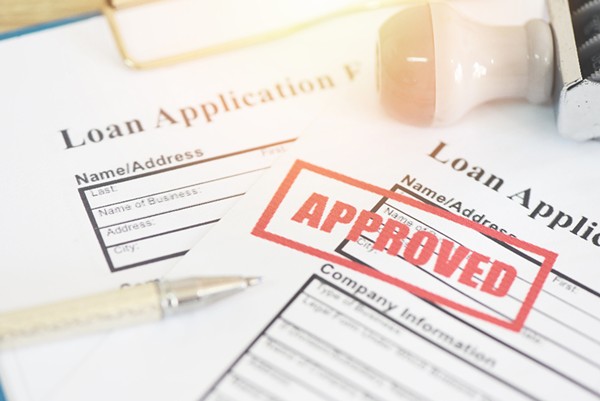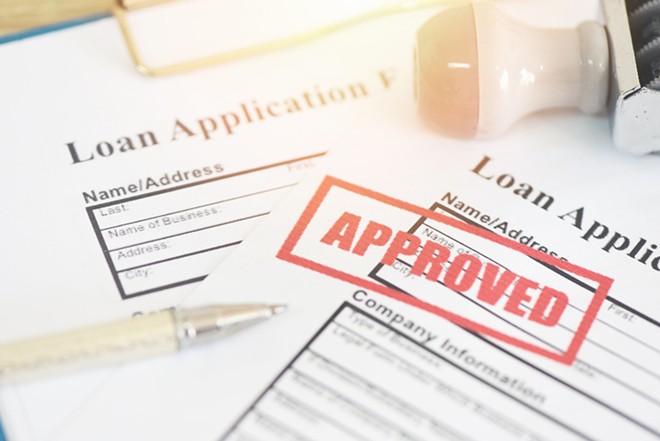In May 2021, Terry Kilcrease thought he saw a lifeline. He was out of work, living in a hotel in Lewisville, Texas, when he ran across a promising ad on Facebook. People who worked for themselves, it said, could still get loans from the government’s then-13-month-old pandemic Paycheck Protection Program.
Kilcrease had just started selling credit card processing systems to small businesses in early 2020 before the pandemic killed much of the need for cash registers. He hadn’t thought he was eligible for the $800 billion program. But the ad, posted by a company called Blueacorn, convinced him it was worth a try.
“We’ve created a 60-second quiz that can tell you if you qualify and how much you can get,” one ad promised. So Kilcrease registered on the Blueacorn site and answered a few basic questions about his business.
“With a few clicks of a mouse, I had applied,” Kilcrease said. It was so quick, he doesn’t recall many details. Blueacorn checked for all required documents before passing along Kilcrease’s approved application to a lender, Prestamos.
Soon after, Kilcrease received loan documents from the Small Business Administration saying he’d been approved for a $4,790 forgivable loan, which he signed electronically and returned. The money would arrive in his bank account within ten business days, Blueacorn estimated.
Kilcrease was relieved.
“It was everything I needed to get going,” he said. “Just that little bitty bit.”
But the money never made it to Kilcrease. And it never appeared for hundreds of thousands of other applicants, either.
ProPublica has been tracking PPP loans since the government first posted millions of them in July 2020. We kept updating our interactive database as the SBA disclosed more loan information. When the last round of the PPP closed, in May 2021, we noticed something strange: The number of loans the government said it had made kept shrinking with every new release.
By the time the SBA posted its latest update in late November, about 575,000 loans had disappeared, subtracted from an original total of 11.8 million. Most of them came through non-bank online lenders or banks that worked with web platforms such as Blueacorn, which solicited and processed huge volumes of applications for small-dollar loans in the final months of the program.
For weeks, not much happened. In August, Kilcrease got through to someone at Prestamos, the lender Blueacorn was working for. She asked for his 2020 tax return, which documented $5,600 in gross income. Then, e-mails show, she told Kilcrease he had provided conflicting numbers to Blueacorn and to the IRS, and his application would be formally denied.
Kilcrease said that he might have been confused about what information Blueacorn was initially asking for when he clicked a few buttons to apply back in May. But then why would they have approved him in the first place, and put him through months of hope, frustration and disappointment?
“They saw a whole lot of profit in people like me, sole proprietors,” said Kilcrease, citing the fee that lenders received for successfully funding small PPP loans. “They were given a hope, and it was just dashed, with no remorse and no recourse for anybody.”
The first round of the PPP, which kicked off in April 2020, mostly went to the largest small businesses. Clogged by applications from companies big enough to have bankers and accountants, the $349 billion fund was exhausted within weeks.
Realizing the need among actual mom-and-pops, Congress authorized another $320 billion in June 2020. That round reached millions more main-street-type companies: coffee shops, hair salons, restaurants, real estate agents.
By winter, the coronavirus recession was still hammering people who’d missed out on earlier rounds. Congress authorized the lending of unused funds and added more, while the incoming Biden administration tailored the rules to help sole proprietorships and independent contractors.
That’s when financial technology companies — user-friendly websites with automated application platforms that often partner with lenders to supply loans — saw a big opportunity.
In the earlier stages of the PPP, banks mostly served existing customers that already had documents on file, making it easy to process their government-backed loans. But as Congress pushed to include businesses on the fringes of the financial system, lenders had to deal with huge numbers of applicants they’d never assessed before.
They often outsourced that task to websites — we’ll call them loan processors — that marketed PPP loans to the self-employed and other small businesses and performed the basic checks required by the SBA. The SBA paid a fee for each funded loan to the lender, which in turn gave a cut to the processor for finding and vetting a borrower.
December’s stimulus package boosted fees up to $2,500 or 50{797b2db22838fb4c5c6528cb4bf0d5060811ff68c73c9b00453f5f3f4ad9306b} of small loans, whichever was less. Loan processors, which utilized aggressive social media outreach to people who had had any kind of self-employment income before Feb. 15, 2020, churned through millions of loan applications quickly.
Orlando venues and promoters need you to bug Marco Rubio about saving our live music scene today

Orlando venues and promoters need you to bug Marco Rubio about saving our live music scene today
By Ray Roa
Blogs
In an effort to keep barriers to entry low, the SBA required very little verification on the front end. Once an application was approved and assigned an SBA loan number, borrowers were forbidden from applying elsewhere. So loan processors had every reason to lock them in quickly, with few anti-fraud measures, said independent fintech analyst Jason Mikula — even if it meant dealing with verification questions later on.
“At the end of the day, if they end up rejecting someone for being suspicious, they’re actually losing money,” said Mikula, noting that building automated fraud models takes time and money, even under normal circumstances. “There were no incentives in place to encourage these companies to be particularly careful about how they went about funding these things.”
Downtown Orlando bars sue federal government over SBA grant disbursement

Downtown Orlando bars sue federal government over SBA grant disbursement
By Alex Galbraith
Blogs
An arms race followed. Fintechs competed for the self-employed, advertising their easy routes to quick, forgivable cash; some said they employed rigorous verification tools following SBA approval. But Blueacorn was the one that got really lucky.
By May 2021, the Biden administration had changed the rules again to prioritize loans made by community development financial institutions, which have access to special funding from the Treasury Department to support underserved populations. Blueacorn, which launched in Phoenix in 2020, happened to partner with two of them: Prestamos CDFI, an arm of the nonprofit service group Chicanos Por La Causa, and Capital Plus Financial, the CDFI subsidiary of a larger holding company called Crossroads Systems.
Those relationships allowed Blueacorn to keep lending through the end of the PPP on May 31, while other lenders were locked out.
When we checked with the SBA, they told us the total number of cancelled loans actually topped 1 million. A sizeable number of those were likely applied for by people who were attempting to defraud the program and didn’t make it through additional screening — it’s unclear how many, since the lenders we talked to declined to specify.
But plenty of would-be borrowers were acting in good faith. Scores of them wrote in to our tip lines, perplexed that they had been listed as loan recipients, since they had applied but never received any money.
Mango’s Orlando launches new show in the latest sign of I-Drive’s recovery

Mango’s Orlando launches new show in the latest sign of I-Drive’s recovery
By Ken Storey
Blogs
Their situations sounded a lot like Kilcrease’s: a quick approval in spring 2021, followed by some kind of snafu, and then a monthslong runaround from companies like Blueacorn, eventually resulting in no money after the lender the companies worked with withdrew its initial approval.
By the end, the two CDFIs appeared to have processed more than $15 billion in loans to 955,000 small businesses, nearly all with Blueacorn. Blueacorn declined to detail its fee split arrangement with banks and other vendors. But Crossroads Systems said in an earnings report that it had made approximately $930 million on the program, $606 million of which went to its loan processors. (Crossroads also paid out a $40 per share special dividend as a result of what it called the “windfall” fee income, while keeping $120 million to reinvest in lower-income communities.)
Fintechs have positioned themselves as champions of the little guy, reaching truck drivers and dog walkers, especially people of color, who’d been overlooked by the big banks.
The companies’ promises to get money to thousands of independent workers from underserved communities is broadly true — but also somewhat overblown.
Orlando music venues still waiting on federal aid after months of bureaucratic gridlock

Orlando music venues still waiting on federal aid after months of bureaucratic gridlock
By Matthew Moyer
Blogs
In May, June, and July, about 285,000 loans disappeared from the SBA’s loan database. The companies that originally processed the loans told ProPublica there were a number of reasons why so many ended up canceled after having been approved by the SBA. Some appear to have been held up by borrower errors and second thoughts, but many cancellations were the result of the SBA’s loose requirements for pre-approval screening.
One of the largest sources of canceled loans was Biz2Credit, an online lender founded in 2007, which withdrew about 115,000 loans after approving an original total of more than 300,000. A representative of the company, crisis communications consultant Michael Sitrick, said that the company employed “detailed underwriting protocols” after submitting the loans to the SBA. Canceled loans, he said, resulted from a combination of applications determined to be fraudulent after further checks, people who didn’t respond to additional requests for documentation and people who voluntarily withdrew their applications.
“Lenders were required to stop fraud whenever they found it,” Sitrick wrote in an email. “Given the sophistication of widely available document forgeries and other enterprise fraud, it was virtually impossible to detect fraud only by reviewing select documents prior to submission to the SBA.”
The pile of canceled loans also included about 30,000 made by an entity newly created by the lender Fountainhead, which prior to the pandemic had specialized in SBA-backed loans. Still, they had thousands of borrowers who didn’t sign their loan documents and inexplicable cancellations by the SBA itself after the agency had approved loans and banks had paid out the money.
“On occasion it would say ‘duplicate tax ID discovered,’” said Fountainhead’s chief operating officer, Michael Bland, referring to the SBA. “OK, well, what was your screening on the front end for? You went through your process and approved it, we closed it, I don’t know why that might be an issue now.”
Last month, Blueacorn lending partner Crossroads Systems agreed to purchase Fountainhead for an undisclosed amount.
When the SBA posted its most recent database update the day before Thanksgiving, it had dropped another 294,000 loans. About 140,000 of them belonged to the two CDFIs that had primarily worked with Blueacorn, Prestamos and Capital Plus, which accelerated their business in the three weeks after the program closed to regular lenders. In May alone, they approved at least 458,300 loans.
At the peak of the program, Blueacorn said, it had 300 people in the Phoenix area reviewing a deluge of loan applications. A quick scan of each one would usually lead to a quick signoff by the SBA.
But sometimes, between approval and funding, Blueacorn would find flags of fraudulent activity like an improbable concentration of applicants with very similar paperwork in a small geographic area — hairdressers making more than $100,000 a year on the south side of Chicago, for example. The processor would ask those borrowers for more documentation, and if they failed to provide it, cancel the loans.
Blueacorn said that thousands of loans it had approved and attempted to fund, meanwhile, were rejected by banks where applicants had savings accounts. Some of the banks had run their own know-your-customer checks on the accounts and sent them back to the processor for additional verification. Others cut off fintech processors entirely if they seemed to be vectors for fraud, causing problems for those who were genuine.
“Towards the end of the program, the willingness of recipient banks to work with PPP lenders got worse by the minute,” said Barry Calhoun, Blueacorn’s CEO.
Eric Kinney is the senior vice president for risk at Oxygen, a banking platform for small businesses. He said he saw so many people attempting to move PPP money into offshore accounts or into cryptocurrency assets that he blocked loan proceeds from “four main PPP lenders.”
“There are a couple lenders who we’ve said no to, we’re not going to accept any more payments,” Kinney said, declining to name the companies. “A referral channel that has a high fraud rate on it, it’s our job as a company to monitor that and block certain situations.”
Loan processors would try to work with borrowers and their banks to provide the requested information. If that didn’t succeed, they had the option of putting the money on a debit card, but that required even more documentation from borrowers, resulting in an outpouring of angry posts on internet message boards like Trustpilot, the Better Business Bureau, Reddit and Facebook.
Now, borrowers who were approved but never received their money are plaintiffs in two lawsuits filed against Prestamos CDFI and Capital Plus Financial last October and December, saying that the failure to fund the loans constitutes a breach of contract. In a motion to dismiss, Prestamos said that the loan document created no obligation to actually fund the loan, and a spokesperson declined to comment further on the case. Capital Plus Financial hasn’t yet filed any responses, but told ProPublica that the sole named plaintiff had provided an “illegible” tax return that wasn’t signed, which is why the company decided to revoke his loan.
Blueacorn’s Calhoun said much of the hassle could have been avoided from the beginning had the SBA allowed lenders to access more documents that would ensure the borrower was legitimate. Creating a quick way for certified, regulated loan processors to pull an applicant’s tax records, for example, would have provided a hard check on who was eligible.
“A few adjustments would’ve gotten rid of a lot of the lazy fraud,” said Calhoun. “Because there was so much ambiguity, it encouraged a lot of people.”
This happened more smoothly in other countries where companies file federal taxes quarterly or even monthly, allowing the government to know their exact income without the need for lenders to request documentation that was sometimes difficult to verify. Instead, the SBA allowed applicants to file draft tax returns, which can easily be manipulated.
The whole experience left Terry Kilcrease feeling cynical.
“The big companies made out like fat cats, the lenders made out like fat cats, all these companies that already had plenty of money,” Kilcrease said. “The people like me who are struggling to get there were just completely forgotten about.”
–
Stay on top of Central Florida news and views with our weekly newsletters, and consider supporting this free publication. Our small but mighty team is working tirelessly to bring you Central Florida news, and every little bit helps.




